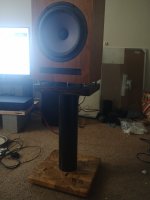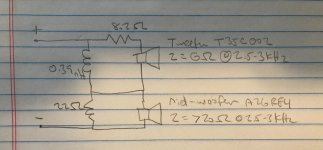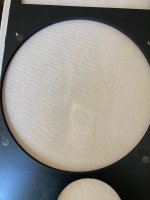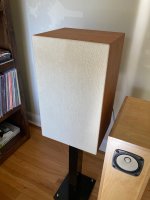The Dynaco A25s were stuffed to the gills with thick fiberglass batting, sides, top, bottom and back. Granted chipboard rather MDF, and slightly different dimensions I believe. You could give it try, cheap tweak and see what you hear.
Thanks for that background. I was speaking with a friend yesterday who built a pair some years ago and he was suggesting lining the interior with Dynamat. I may try either more polyfill or even fiberglass as you suggest, once the speakers are broken in.
were stuffed to the gills with thick fiberglass batting
Rockwool, not fiberglass.
dave
lining the interior with Dynamat
AFAIC something that degrades good box performance, may well help MDF boxes like the A26 NDF carcass
dave
Built the Madisound kit and purchased the cabinets. Observations....... The woofer without crossover does

seem to have a smooth breakup. There is some midrange suck out but the tweeter does go pretty low. Driven with 3 watt tube amp plays ok. Built this as a retirement everyday listening speaker and it serves the purpose. My speaker stands are buthcer blolck bases, pvc pipe to 1.5" plywood. Sand filled with threaded rod inside.

seem to have a smooth breakup. There is some midrange suck out but the tweeter does go pretty low. Driven with 3 watt tube amp plays ok. Built this as a retirement everyday listening speaker and it serves the purpose. My speaker stands are buthcer blolck bases, pvc pipe to 1.5" plywood. Sand filled with threaded rod inside.
Last edited by a moderator:
I have 10 ohm with 3.3 uf cap: sounds fine but I do a little EQ in my room. The T35 is a beautiful tweeter to my ears.but how does the tweeter sounds? please tell me if somebody has used it... how is it?
I've purchased the A26 kit from Solen here in Canada. I've deviated from the design as I've decided to clone the A35 as opposed to the A25. I am very happy with the sound and I've experimented a bit. Now the tweeter, well I'll tell you straight out I love it. Not sure if it's the tweeter, the implementation with the SEAS A26RE4 woofer, or the cabinet size, etc...but I find it detailed, smooth, not tiring (as opposed to other speakers I've owned) and very well integrated with the woofer from the A26 kit. I had cabinets build out of birch.Since there were many uses of seas A26 kit I would like to know more about the sound quality of the Tweeter T35 used in it. Can anyone please give a review of that tweeter.
I am listening to music as I type this (Luna).
Playing around with my A35 clones (A36), I come to the conclusion that I'm happy that I stuck with the dynaco cabinet dimensions to a T; even if my tweeter is not in it's optimal position. I implemented them with the 3.3 uf and 10 ohm resistor supplied (I could upgrade the cap in time).
1) I did, in time, modify the design by adding an external aperiodic vent and that helped the lower end a bit while still keeping the sound signature intact: sweet mids and nice taut bass.
2) Yesterday I removed the "internal" aperiodic vent (A35 unique design) to see how that would impact the performance of the speaker system. The bass improved, but it sounded more like a one note response (higher Q I take it) and the mid-range became so muddled (I think the woofer level went up and messed things up at the crossover point) that within hours I re-installed the internal vent. This is the way I prefer the sound: better delineated bass that is taut; sweeter more integrated mid-range.
At this moment I realized that speaker design is more difficult that we think and it's easy to muck up a planned design.
I'm of the opinion that the design SEAS offers as a kit is knowledge based; they knew what they were doing.
I'm surprised they did not think of also offering it as an A36 kit: it works really well for me. I wrote them but never heard anything back. LoL.
But deviating from those classic cabinet volumes, and yes there are many options on this site and it's full of knowledgeable folks with great ideas, you may find you need to "tweak" the design, particularly the crossover (it's been done).
By my estimation you would deviate from the single order crossover. On top of the great drivers and concept of integrating them into the offered cabinet size, they are by my estimation, magical. Not perfect but you could do worse for the $1800 I have invested. If you look at the Harbeth P3ESR, this A36 kit (remember I cloned the A35 which has a different cabinet design, not the A25 or A26) is much nicer to listen to and I don't feel like I'm missing anything. I've owned the harbeth and loved them, but they left me wanting in my audio room where I sit 11 feet away. Maybe I was asking to much from them; or maybe the 10 inch woofer gives me just enough of the scale and impact I need to be satisfied. And the Harbeth were $$! The Harbeth are smaller and will surely be able to be installed in a more discreet manner if that is needed (being sealed and all makes it easier to position).
Bottom line: the T35 tweeter is worth it by my estimation. Troels Gravesen also gives it high marks. No regrets on my part after taking a punt and trying this kit.
All the best with your speaker project pursuits.
Interesting. I too have been able to compare my Seas A26s to Harbeth P3s (the anniversary addition) on the same amplifier. Frankly, nothing can or will beat the golden tone of a Harbeth in the midrange, but the Seas had no problem with presence and extension. They fill the room better. If you listen to jazz, or take pleasure in the voicing and harmonics of a plucked string or horn, the Seas A26 can deliver.
Last edited by a moderator:
I've been playing around a bit with an F1J clone, which is a transconductance amplifier, and my Seas A26 2-ways. The single pole series crossover design below sounds pretty good to me and hasn't blown any drivers. It's two resistors and a coil instead of the single resistor and capacitor of the standard single-pole parallel crossover.
The tweeter is crossed at ~2.5kHz using a single parallel coil of 0.39mH, and padded down with an 8.2 ohm series resistor. I thought the tweeter level sounded better a bit higher here than with the standard 10 ohm value as used in the parallel crossover. I also tried crossing the tweeter a little higher at 3kHz with a 0.33mH inductor, but preferred the sound with the 2.5kHz crossover point. Per the original parallel crossover design, the mid-woofer is not crossed, but running it full open produced a muddy / floppy bass which, while fun and bold and not that offensive, seems to be improved a bit by some damping, hence the 22 ohm parallel resistor.
Offering this up in case anyone else has been curious if a current source amp could be made to work well with these simple 2-ways. The sound is addictive- the swing and punch of records with a lot of dynamic range like some of the recent jazz reissues really comes through. This system reproduces vinyl better than any iteration I've tried so far.
The tweeter is crossed at ~2.5kHz using a single parallel coil of 0.39mH, and padded down with an 8.2 ohm series resistor. I thought the tweeter level sounded better a bit higher here than with the standard 10 ohm value as used in the parallel crossover. I also tried crossing the tweeter a little higher at 3kHz with a 0.33mH inductor, but preferred the sound with the 2.5kHz crossover point. Per the original parallel crossover design, the mid-woofer is not crossed, but running it full open produced a muddy / floppy bass which, while fun and bold and not that offensive, seems to be improved a bit by some damping, hence the 22 ohm parallel resistor.
Offering this up in case anyone else has been curious if a current source amp could be made to work well with these simple 2-ways. The sound is addictive- the swing and punch of records with a lot of dynamic range like some of the recent jazz reissues really comes through. This system reproduces vinyl better than any iteration I've tried so far.
Attachments
J-jees! Absolutely!With your permission i will add that XO to the document i have been making.
dave
Hello everyone, I've been away for awhile during Covid time. I have done some work on my A26/A36 SEAS kit clones. Here are some notes if you are interested to read:
1. I tried cloning the A35 and after much listening, it did not work out well. The speaker had no low end punch. The mids were off balance.
2. I installed a resistive vent on the bottom portion of the rear speaker's panel and that helped. That put me on a path to further tune the speaker.
3. After doing much reading online and in this forum, I decided to modify the mid-portion of the cabinet brace which is part of the plan of the original A35. I removed the internal resistive vent and put holes in the mid-section brace as much as possible. This helped the bass response.
4. I tried various other things to see how much more venting I could increase in the rear panel of the cabinet, but at the end of the day, I have a 36 litre birch box (similar dimensions to the orignal A35), with a brace mid-way and a resistive vent at the rear.
5. It's now an A26 but in a bigger cabinet sized like the original A35: bigger is better, right?
6. I use an RME ADI-2 DAC as my DAC-PRE and Audirvana as my source. Feeding AIFF to my DAC, I have Eq'ed the 1.6 kHz frequency range by a 3 db boost with a 1.0 Q setting: this adds presence do the sound and makes the speaker come alive with a more balanced midrange. It sounds wonderful and is all I could hope for a magical midrange presentation.
* Having heard some Harbeth SHL5+ and more directly, the Harbeth 30.1: this kit easily is the latter's equivalent, but the SHL5+ is more comfortably complete to my ears. That said, there are things my build does that eludes the Harbeth speakers, so it really comes down to different strokes for different folks if I may use that cliché.
7. I do wish for more bass, but I have come to accept that at about 50 Hz, that is the limit of what I can achieve without overdriving the woofer. The quality of the sound on offer is top rate: I'm quite smitten with the results (with the correction applied).
8. The impact of the 10 inch woofer is great, but it's no ol' Tannoy HPD 12 or 15 inch woofer in big boxes. A subwoofer will be needed to fill out the bottom end, and I have high expectations that with a KEF KC 62 or Dynaudio Sub 18 the results will be excellent. That will be the next phase of this build, adding a quality sub.
It's been fun. I've learned a lot. Made lot of mistakes, or took things for granted. But hey, with a 35 to 36 litre box + a resistive vent, it sounds mighty fine if you EQ that 1.6 kHz dip. Would I do it again? Answer is yes. I would change a couple of design details and limit my expectations with regards to the bass, this understanding that the bass offered is of very good quality with no bloat.
1. I tried cloning the A35 and after much listening, it did not work out well. The speaker had no low end punch. The mids were off balance.
2. I installed a resistive vent on the bottom portion of the rear speaker's panel and that helped. That put me on a path to further tune the speaker.
3. After doing much reading online and in this forum, I decided to modify the mid-portion of the cabinet brace which is part of the plan of the original A35. I removed the internal resistive vent and put holes in the mid-section brace as much as possible. This helped the bass response.
4. I tried various other things to see how much more venting I could increase in the rear panel of the cabinet, but at the end of the day, I have a 36 litre birch box (similar dimensions to the orignal A35), with a brace mid-way and a resistive vent at the rear.
5. It's now an A26 but in a bigger cabinet sized like the original A35: bigger is better, right?
6. I use an RME ADI-2 DAC as my DAC-PRE and Audirvana as my source. Feeding AIFF to my DAC, I have Eq'ed the 1.6 kHz frequency range by a 3 db boost with a 1.0 Q setting: this adds presence do the sound and makes the speaker come alive with a more balanced midrange. It sounds wonderful and is all I could hope for a magical midrange presentation.
* Having heard some Harbeth SHL5+ and more directly, the Harbeth 30.1: this kit easily is the latter's equivalent, but the SHL5+ is more comfortably complete to my ears. That said, there are things my build does that eludes the Harbeth speakers, so it really comes down to different strokes for different folks if I may use that cliché.
7. I do wish for more bass, but I have come to accept that at about 50 Hz, that is the limit of what I can achieve without overdriving the woofer. The quality of the sound on offer is top rate: I'm quite smitten with the results (with the correction applied).
8. The impact of the 10 inch woofer is great, but it's no ol' Tannoy HPD 12 or 15 inch woofer in big boxes. A subwoofer will be needed to fill out the bottom end, and I have high expectations that with a KEF KC 62 or Dynaudio Sub 18 the results will be excellent. That will be the next phase of this build, adding a quality sub.
It's been fun. I've learned a lot. Made lot of mistakes, or took things for granted. But hey, with a 35 to 36 litre box + a resistive vent, it sounds mighty fine if you EQ that 1.6 kHz dip. Would I do it again? Answer is yes. I would change a couple of design details and limit my expectations with regards to the bass, this understanding that the bass offered is of very good quality with no bloat.
Last edited:
@Julesottawa
having been the owner of both Harbeth shl5plus and seas a26, i agree with every of your points. we have very similar findings.
having been the owner of both Harbeth shl5plus and seas a26, i agree with every of your points. we have very similar findings.
Hi all.
Since this is an A26 kit thread (I wouldn't want to steer the conversation in a different direction), does anybody who built the A26 kit from Madisound with pre-built 1 cu-ft boxes have a case of the white grille material becoming yellow where the woofer surround comes in contact with it?
I don't have a photo right now, but on mine the outline of the woofer surround is visible on both grilles as a yellow circle...
On a another note, I found that the 12 ohm resistor gave best balance so far, and will continue to experiment with adding AcoustaStuff in the box. Bass indeed is limited for a 10" woofer in my 12'x22' room, but the overall sound is fantastic.
BTW I am in Ottawa too...
--Christian
Since this is an A26 kit thread (I wouldn't want to steer the conversation in a different direction), does anybody who built the A26 kit from Madisound with pre-built 1 cu-ft boxes have a case of the white grille material becoming yellow where the woofer surround comes in contact with it?
I don't have a photo right now, but on mine the outline of the woofer surround is visible on both grilles as a yellow circle...
On a another note, I found that the 12 ohm resistor gave best balance so far, and will continue to experiment with adding AcoustaStuff in the box. Bass indeed is limited for a 10" woofer in my 12'x22' room, but the overall sound is fantastic.
BTW I am in Ottawa too...
--Christian
@christiang
looks like maybe a air quality issue, woofer moving air in/out rapidly……do you smoke in the house, use a woodstove, or fry alot?
looks like maybe a air quality issue, woofer moving air in/out rapidly……do you smoke in the house, use a woodstove, or fry alot?
- Home
- Loudspeakers
- Multi-Way
- SEAS A26 Speaker Kit


